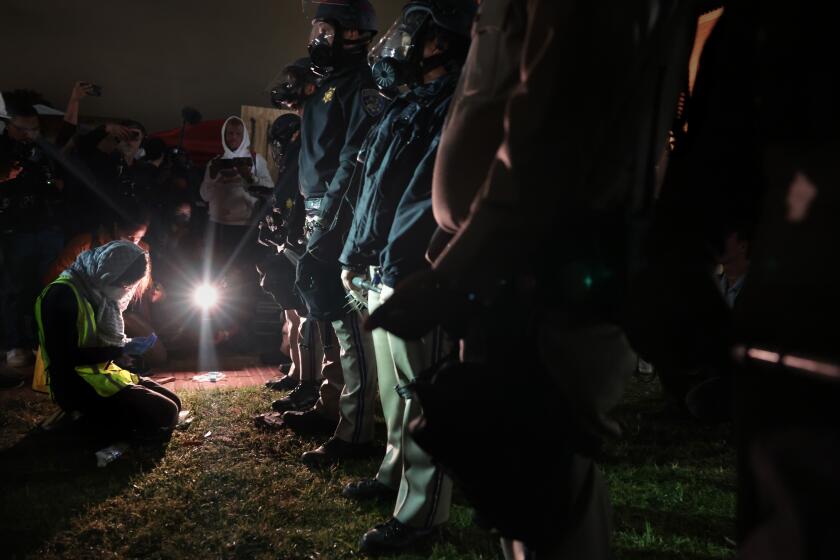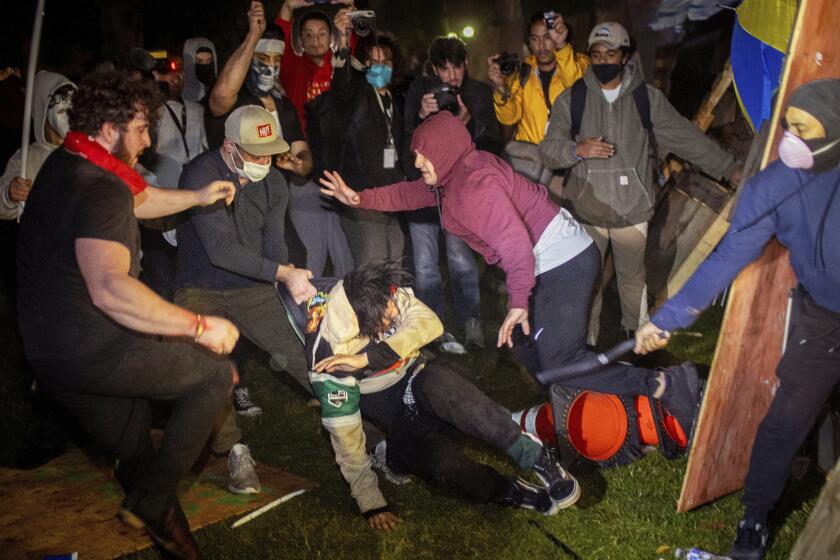Students at CSUN Soon Will Register by Telephone : Education: Hoping to do away with long lines, the university plans to make it possible to enroll in, add or drop classes in five minutes.
Beginning next semester, Cal State Northridge’s more than 30,000 students will be able to register for, add or drop classes from anywhere in the world, all in about five minutes.
In an effort to end the long lines that are common as students enroll or adjust their schedules during registration week, the university has installed a touch-tone telephone registration system that can enroll 150 students every half hour.
The system is set up to work even faster, but Lorraine Newlon, director of admissions and records, said officials programmed it to guarantee that students are able to get through at their assigned time. “We wanted to make sure students were not likely to get busy signals,” she said.
The system, called TTR, not only enrolls students in the classes of their choice, but tells them when a class is closed or canceled and, if they wish, searches its database for an alternative. “Rather than the student running around campus frantically searching for a class to put in their schedule, the computer can immediately locate a class that is open,” Newlon said.
Although fewer classes are being offered than in the past because of state budget constraints, Newlon said the university actually may accommodate more students because they will be able to locate classes more easily. Also, she said, when students are able to find open classes, they probably will take fuller course loads, allowing many to graduate sooner.
The TTR system was pioneered six years ago by Brigham Young University and is now in use at more than 200 universities across the country. At least 300 others are exploring the possibility, according to Robert W. Spencer, former dean of admissions at BYU.
“Because of touch-tone registration, the student registration process is complete for more students by the second or third day rather than the second or third week,” of a semester or quarter, Spencer wrote in a recent issue of the College and University journal.
In the California State University system, touch-tone registration is in use at the Long Beach, Hayward, San Luis Obispo and San Jose campuses. Students at Northridge and San Diego State will join the other campuses next semester.
“It’s been great here. It’s basically put registration back in the hands of students,” said Nora McLaughlin, registrar at Cal State Long Beach, which adopted the system three years ago to become the first major university in California to do so.
McLaughlin said students can manipulate their schedules any way they please and instantaneously know their exact class schedule. With the university’s former mail-in system, students had to wait a month to six weeks to find out if they were enrolled in the classes of their choice, she said.
“This way the students call and if something’s full they can make an alternative choice immediately,” McLaughlin said. “It’s been a tremendous relief to our students.”
Cal State Northridge mailed instructions for using the touch-tone telephone registration to students last week. They will start using the system Jan. 2 to register for the spring semester that begins Jan. 27.
Newlon said each student will be given a personal identification number to gain access to the system and will be assigned a time during the “prime time” hours of 7 a.m. to 7 p.m. to call the system. Students must have paid their enrollment fees or the system will not accept their calls.
“They call from anywhere on the planet as long as they have access to a touch-tone phone,” Newlon said. “For those who do not, we have several phones set aside for students to use.”
If a student is unable to call at his or her assigned time, the system still will allow the student to register during the next 24 hours. “We’ve tried to be as flexible as possible,” Newlon said. “If a student is on the freeway or something, there is a window.”
Once connected to the system, students are greeted by a pleasant voice some may recognize. Stephen J. Sinclair, professor of communicative disorders, spent hours over the summer in a CSUN studio recording instructions and responses for the system.
“We wanted a nice, clear voice most everyone could understand,” Newlon said. “We have quite a number of hearing-impaired students. He was nice enough to volunteer his time.”
If a student wants to add or drop a class after registering, that also can be done by telephone.
The entire process is simple and takes about five minutes, Newlon said, even for those who are not electronics-minded. To identify any problems, the system was given a trial run during freshman orientation this fall. No major glitches were discovered. Several faculty members and students are also testing it on an ongoing basis.
“I like it a lot,” said Mike Wilson, a senior psychology major who has tested the system. “It’s really easy. With the old way, you had to wait to see if you got the class for two months sometimes. This way, it’s instantaneous. I’m quite impressed.”
Don Brownlee, an associate professor of speech communications, said the touch-tone registration will give faculty members immediate feedback about whether their courses are filling up, allowing them time to add or cancel sections or classes in response to demand. The new system will also allow the university to notify students more quickly if a class has been canceled.
The system will not allow students to keep their options open by enrolling in two sections of the same course, Brownlee said. “It caught me trying to do that,” he said. “I’ve tried and I can’t beat it.”
Newlon said the equipment, which cost $100,000, is expected to more than pay for itself based on the experience of other universities. The only other costs are monthly fees paid to Pacific Bell for 100 telephone lines.
McLaughlin said the amount of time clerks spend on registering students has gone down since Cal State Long Beach instituted the system. “But the main benefit is to the student,” she said.
Newlon said other uses for the system, including grade-reporting and student elections, are under study at CSUN. Other universities have used TTR in the financial aid and admission processes and to take campus surveys.
“The possibilities are practically endless,” Newlon said.
More to Read
Start your day right
Sign up for Essential California for news, features and recommendations from the L.A. Times and beyond in your inbox six days a week.
You may occasionally receive promotional content from the Los Angeles Times.






